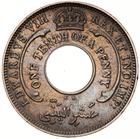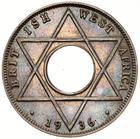The British West African Pound was the currency of British West Africa, a group of British colonies, protectorates and mandate territories - Nigeria, Sierra Leone, Ghana (originally Gold Coast) and Gambia.
The British West African Pound was equal to the (pre-decimal) Pound Sterling and was similarly subdivided into 20 shillings, each of 12 pence. Unlike its Imperial counterpart though, the British West African Pound - uniquely among British colonies - also had a denomination worth one tenth of a penny - due to the low standard of living in the African colonies, where people had considerably less money than people elsewhere. The denomination was worth 1/2,400th of a pound (i.e., 2,400 of these coins made one pound).
This one year type is one of the few coins issued worldwide in the name of King Edward VIII, who abdicated before the end of the year.
After decolonisation, the coins were replaced by the various new countries as they introduced their own independent currencies:
- Nigeria introduced the Nigerian Pound in 1958
- Ghana introduced in Ghanaian Pound in 1958
- British Cameroon (on unification with Cameroon) adopted the Central African CFA Franc in 1961
- Sierra Leone introduced the Leone in 1964
- Gambia introduced the Gambian Pound in 1965
In some places, British West African coins circulated in parallel with the new coinage until 1968. | 



